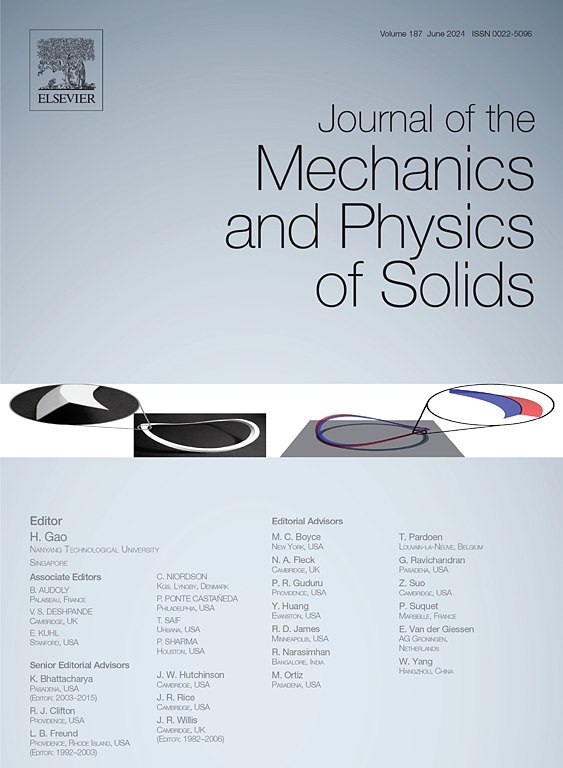新型无机电不稳定介电弹性体的连续介质模型
IF 5
2区 工程技术
Q2 MATERIALS SCIENCE, MULTIDISCIPLINARY
引用次数: 0
摘要
传统的介电弹性体在电场达到一定阈值时表现出不稳定的响应,称为机电不稳定性,这极大地限制了这些软活性材料的广泛应用。最近,一种双峰网络介质弹性体被设计出来,由于在中应变状态下有明显的应变硬化效应,因此没有机电不稳定性(Science, 2022, 377,228)。在这项工作中,我们建立了一个本构模型来全面描述这种新型介电弹性体的机械和电激活响应。自由能密度由与时间无关的超弹性分量、与时间有关的粘性分量和电分量组成。提出了依赖于第一应变不变量和第二应变不变量的超弹性函数来充分捕捉应力响应。电自由能采用理想介电弹性体的形式。随着粘性效应的进一步结合,该模型能够描述静态电致动行为以及频率相关的方波电压负载下的致动性能。该模型还应用于柔性机器人领域中广泛应用的管状驱动器的有限元分析。本文章由计算机程序翻译,如有差异,请以英文原文为准。
A continuum model for novel electromechanical-instability-free dielectric elastomers
Traditional dielectric elastomers exhibit an unstable response when the electric field reaches a certain threshold, known as electro-mechanical instability, which significantly limits the broad application of these soft active materials. Recently, a bimodal-networked dielectric elastomer has been designed without suffering from the electro-mechanical instability due to a clear strain stiffening effect in the median strain regime (Science, 2022, 377, 228). In this work, we develop a constitutive model to fully describe the mechanical and electro-activated response of this novel dielectric elastomer. The free energy density consists of a time-independent hyperelastic component, time-dependent viscous components and an electrical component. A hyperelastic function dependent on both the first and second strain invariants is proposed to fully capture the stress response. The form of ideal dielectric elastomers is adopted for the electrical free energy. With further incorporation of viscous effects, the model is able to describe both static electro-actuated behavior as well as the frequency-dependent actuation performance upon a square wave voltage loading. The model is also implemented for finite element analysis to design tubular actuators which have been extensively used in the area of soft robotics.
求助全文
通过发布文献求助,成功后即可免费获取论文全文。
去求助
来源期刊
CiteScore
9.80
自引率
9.40%
发文量
276
审稿时长
52 days
期刊介绍:
The aim of Journal of The Mechanics and Physics of Solids is to publish research of the highest quality and of lasting significance on the mechanics of solids. The scope is broad, from fundamental concepts in mechanics to the analysis of novel phenomena and applications. Solids are interpreted broadly to include both hard and soft materials as well as natural and synthetic structures. The approach can be theoretical, experimental or computational.This research activity sits within engineering science and the allied areas of applied mathematics, materials science, bio-mechanics, applied physics, and geophysics.
The Journal was founded in 1952 by Rodney Hill, who was its Editor-in-Chief until 1968. The topics of interest to the Journal evolve with developments in the subject but its basic ethos remains the same: to publish research of the highest quality relating to the mechanics of solids. Thus, emphasis is placed on the development of fundamental concepts of mechanics and novel applications of these concepts based on theoretical, experimental or computational approaches, drawing upon the various branches of engineering science and the allied areas within applied mathematics, materials science, structural engineering, applied physics, and geophysics.
The main purpose of the Journal is to foster scientific understanding of the processes of deformation and mechanical failure of all solid materials, both technological and natural, and the connections between these processes and their underlying physical mechanisms. In this sense, the content of the Journal should reflect the current state of the discipline in analysis, experimental observation, and numerical simulation. In the interest of achieving this goal, authors are encouraged to consider the significance of their contributions for the field of mechanics and the implications of their results, in addition to describing the details of their work.

 求助内容:
求助内容: 应助结果提醒方式:
应助结果提醒方式:


